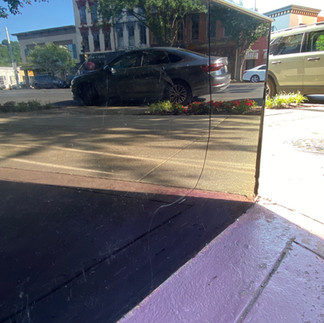How identification and maintenance can protect your building's historical integrity!

Pigmented Structural Glass is commonly known as Carrara Glass or Vitrolite. The glass was originally only produced in white color but was soon expanded to more colors like green, black, and beige. The black and green colors can be seen frequently here in downtown Madison.
The creation and widespread use of structural glass was a response to the more modern architectural styles of the 20th century. This glass was often utilized to update older building facades and modernize them to compete with the popular architectural styles of the time. Its presence here in Madison confirms that several facades were altered in order to be more in line with the changing trends. The versatility of the glass quickly allowed its popularity to soar because of the many ways it could be used in both the interior and exterior of a building.
Maintenance of the glass can be fairly simple as long as it remains structurally sound. For cleaning, the glass normally requires only a damp cloth. Relatively easy maintenance was part of its initial appeal as a building material. However, over time, deterioration in the support system can create issues and cause the glass to fall, slip, crack, or break. Normally, damage to the structural glass is usually from either decline of the joint cement, breakdown of the adhesive, or force from an accident or vandalism.
Nevertheless, there are ways to fix the damage! To repair the cement joints, modern-day silicone compounds can be utilized to reseal the area and prevent moisture from creating more issues. Any cracks in the glass should be repaired as opposed to simply replacing the glass. If possible, patch the crack with appropriate colored caulk to stop any potential water damage that could occur. Removing the panels of glass that have a failing adhesive and reapplying the adhesive is a more difficult project that requires multiple steps in order to properly remove the panel, remove the old adhesive, reapply the new adhesive, and place the panel back in its proper location.
Replacement of damaged or missing panels of glass can be complicated due to its extremely limited production and supply. There are a couple of modern substitutes that could be used if the originals are not able to be located. Ultimately, each building is different and will each require a unique plan to preserve the historical integrity of its facades.
Resources
More information and specific instructions about this process can be found in the National Park Service's Preservation Brief #12.
We can’t wait to see you downtown!
#madisonmainstreet #wearemainstreet #downtownmadisonin #visitmadisonin #historicmadison #carraraglass #vitrolite #historicpreservation #historic #structuralpigmentedglass #shopmadisonmainstreet #shopmadisonin #glass #pigmentedglass #preservation
Written by
Emily McKinney
Madison Main Street Program
Intern
###















Comentarios